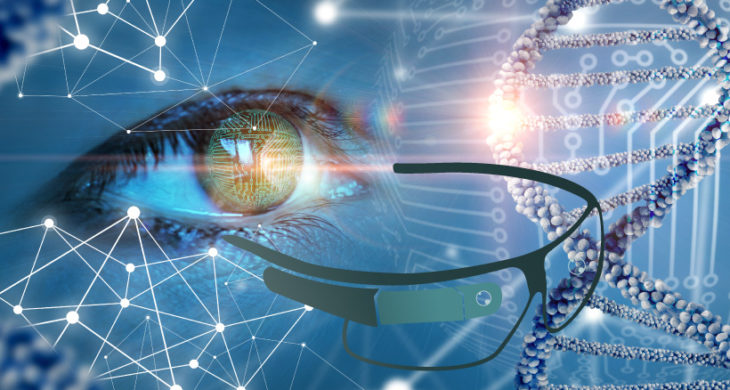
Date: 27th May 2021
Retinitis pigmentosa (RP) is the name of a group of inherited neurodegenerative eye conditions, which affects the light-sensitive retina. Onset of symptoms is usually gradual starting during childhood or early adolescence and can lead to complete blindness. With the exception of a gene replacement therapy for one form of early-onset RP, there are currently no approved therapy for RP. Now, researchers use optogenetic therapy to genetically alter cells to produce light-sensitive proteins, restoring partial vision to a patient via the use of light-stimulating goggles.
RP is the leading cause of inherited blindness, and affects between 1.5-2 million people worldwide. It is caused by mutations in over 71 different genes and whilst gene replacement therapy for RP is a viable option for treatment, only one is currently approved replacing the faulty RPE65 gene. Due to the shear number of genes involved in RP other therapies such as optogenetics vision restoration may provide as more viable strategy. Optogenetics is a mutation-independent approach for restoring visual function at the late stages of RP after vision is lost, and typically involves the use of light to control genetically modified cells which express light-sensitive ion channels.
Now, researchers at the University of Basel, Switzerland, and the University of Pittsburgh, US, led by Botond Roska and José-Alain Sahel in collaboration with GenSight Biologics, have combined intraocular injection of an adeno-associated viral vector encoding ChrimsonR with light stimulation via engineered goggles to treat a RP patient with low visual acuity . Following optogenetic therapy and training with goggles the patient acquired the ability to perceive, locate, count and touch objects.
The team started by using an optogenetic adeno-associated viral (AAV) vector which encoded the light-sensing channel rhodopsin protein, ChrimsonR, fused to the red fluorescent protein, tdTomato. ChrimsonR senses amber light, which is safer for retinal cells than the blue light which is frequently used for other optogenetic research. The fusion protein with tdTomato increased the expression of ChrimsonR in the cell membrane which optimised light sensitivity. The therapy was administered via a single intravitreal injection delivered into the eye with the worst sight, and targeted the foveal retinal ganglion cells – a region responsible for sharp central vision.
The patient – a 58-year-old male, who was diagnosed with RP 40 years ago, had a visual acuity limited to light perception prior to treatment. Nearly 5 months after the gene therapy, the patient began training with goggles. These were developed by the team and were outfitted with a camera that captured and projected visual images onto the retina in amber wavelengths of light, those wavelengths sensed by the ChrimsonR.
The patient began reporting sign of visual improvement seven months after the training with the specialised goggles had began. The team designed a set of tests to assess sight recovery, for example perceiving, locating and touching a single object placed on a white table. Here, the success rate was similar for the different tasks; perceive - 64%, locate - 64%, touch - 57%, pre treatment the patient was unable to perceive any of the objects and therefore could also not locate or touch them. The patient was also now able to correctly count numerous objects on the table (63%), a task he was previously unable to perform. These improvement however, only occurred with the goggles on, and returned to pre-treatment baseline levels (0%) when the goggles were removed.
Finally, the team wanted to investigate the relationship between neuronal activity and partial sight recovery using a noninvasive brain recording technique, extracranial multichannel electroencephalography (EEG). The EEG reading in response to the presence or absence of an object in front of the patient showed that the visual cortex of his brain was changed in response to him wearing or not wearing the goggles. This confirmed the brain activity was related to the visual object and that the retina was thus no longer blind.
Conclusions and future applications
Here, the authors show the first evidence that injection of an optogenetic sensor-expressing gene therapy vector combined with the wearing of light-stimulating goggles can partially restore visual function in a patient with RP who had a very limited visual acuity - light perception only. After treatment the patient could perceive, locate, count and touch objects with the use of specialised goggles, tasks that were previously unachievable. These data represent an important step in the treatment of genetically determined blindness.
The patient here, was a participant of the open-label phase I/II first-in-human PIONEER clinical trial to evaluate the safety and tolerability of GS030 (the product candidate described here) which is sponsored by GenSight Biologics. A total 12-18 subjects are planned to be enrolled. Botond Roska and José-Alain Sahel are co-founders of GenSight Biologics and have been working on optogenetic therapy for 16 years in the lab, it’s translation into a proof-of-concept in a patient has been an “unique experience”.
We are starting to see many gene therapies and novel approaches being applied to restore vision. Unilateral gene therapy has surprisingly improved vision in both eyes as a result of Leber hereditary optic neuropathy, gene therapy to reset the epigenetic clock was able to restore vision in mice. Other gene therapy to deliver light sensitive proteins have also been successfully applied in preclinical models. Interestingly, the success of the approach here is the additional use of the light-stimulating goggles, without which visual improvement did not occur. Other bionic devices are currently being prepared for clinical trials such as Gennaris, a cortical vision prostheses aimed at restoring vision by delivering electrical stimulation to the visual cortex. Gennaris bypasses the need for gene therapy, and is wired directly into the brain.
The hope is that GS030 – the innovative combination of two complementary components - gene therapy and biomimetic goggles, will change the way we treat advanced RP, and improve the vision and quality of life for RP sufferers. It may also translate to other eye conditions that cause sight loss although it does require the optic nerve to remain functional.
For more information please see the press release at the University of Basil or GenSight Biologics
Sahel, J.-A., Boulanger-Scemama, E., Pagot, C., Arleo, A., Galluppi, F., Martel, J.N., Esposti, S.D., Delaux, A., de Saint Aubert, J.-B., de Montleau, C., et al. (2021). Partial recovery of visual function in a blind patient after optogenetic therapy. Nature Medicine.
https://doi.org/10.1038/s41591-021-01351-4

